Published
on 18
Sep 2021
|
All rights reserved.
|
|
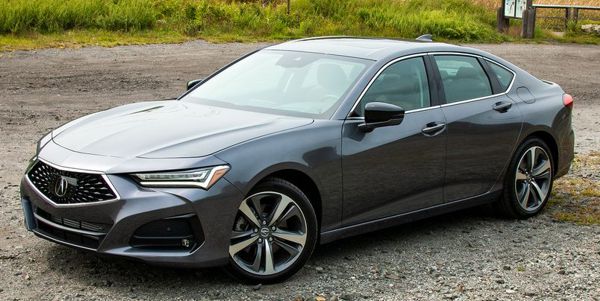
|
|
The
Acura finally gets a dedicated platform required to match European
sports sedans.
|
|
This is the second
generation Acura TLX, or the 5th generation if you take its predecessor
TL into account. It is Honda's challenger to BMW 3-Series, although for
so many years its Accord-derived front-wheel-drive platform failed to
materialize that promise.
The new generation is again built on a front-wheel-drive, transverse
engine platform, but this time around it deviates a lot from its Honda
siblings, so much so that Acura calls it a standalone platform. As you
can see, its proportion is closer to a conventional rear-drive car. The
cabin is pushed rearward thus the bonnet is much longer than the norm
of FWD cars. Tape measurement doesn't lie – the new car has its front
axle pushed 200mm further away from the dashboard mounting point. The
wheelbase is stretched by 95mm to a generous 2870mm, while the body
gets 55mm wider and 15mm lower for a sportier proportion. Front and
rear tracks are widened by 30 and 40mm, respectively.
Styling is subjective, but most agree the new TLX looks more
adventurous than the car it replaces, with more curves, edges and
crease lines to better define its own character. The sleeker, wider and
lower stance look sportier. The radical shapes of its headlights,
grilles and bumper intakes might take some getting used to, but the
diamond elements in its grille look fantastic. The California design
team
allows you to choose chrome or black grilles and window frames,
rectangular or quad-round exhaust. You may also opt for some very
vibrant colors rarely found on executive cars, such as gold, red and
blue. Frankly, some combinations could make the TLX like a Pontiac.
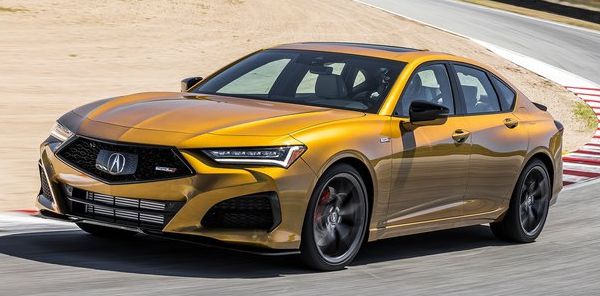
|
|
Type
S label returns with V6 turbo and SH-AWD.
|
|
The chassis is primarily made of steel, but a number of parts up front
have been converted to aluminum, such as bonnet, fenders, bumper beam
and the cast aluminum suspension tower brackets. Furthermore, the
battery has been moved to the trunk to improve weight distribution.
That said, the added length between the front axle and cabin is largely
wasted, because the engine is still mounted transversely between the
front wheels rather than behind the front axle as in some
"front-mid-engined" cars could do. As a result, the base TLX has a
weight distribution of 58:42 front to rear, just 2% improvement over
its predecessor. Opting for 4WD will turn it to 57:43, but a V6 engine
does the opposite to the Type S, worsening the balance to 59:41.
The body is said to be the stiffest in Honda's lineup bar the
carbon-fiber NSX. Compared with the old car, it is 50 percent stiffer
in torsional rigidity, or even 100 percent around the suspensions.
Speaking of suspension, it is also a major improvement, as the front
axle
has abandoned MacPherson struts for a pair of double-wishbone
suspensions, reminding us the Hondas of good old days. Amplitude
selective dampers soldier on the base TLX, but now you have the option
of electronic adaptive dampers, which is standard on higher trim
levels. Predictably, Type S gets stiffer springs, dampers and anti-roll
bars, plus reinforcement braces around the front and rear suspensions
to increase torsional rigidity by a further 13 percent,
Type S also sports stronger footwork and stoppers. It can be equipped
with lightweight 20-inch wheels and 255/35R20 Pirelli P-Zero rubbers
which offer 20 percent more grip. By-wire servo actuates larger Brembo
brakes.
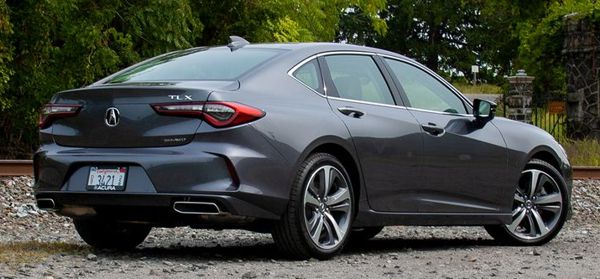 |
|
That
cab-rearward proportion means an FWD car without the space advantage of
FWD.
|
|
Performance is also improved. While the outgoing TLX relied on all
naturally aspirated engines (206hp 2.4-liter four or 290hp 3.5-liter
V6), the new car makes do with turbocharging motors. Base model employs
a 2.0-liter direct-injection turbo four that makes 272hp and 280lbft of
torque, outstanding numbers for a 2-liter. It is practically a Honda
Accord engine made at higher state of tune, featuring sodium-filled
exhaust valves and forged connecting rods to withstand the increased
stresses. The DOHC cylinder head gets dual continuous cam phasing plus
VTEC variable valve lift at the exhaust side. The base TLX
goes from 0-60 mph in about 6 seconds, almost a second quicker than the
old car. However, it still takes more than half a second longer than
the BMW 330i or Audi A4 2.0TFSI with which it competes, blame to a kerb
weight in the region of 1700kg for front-wheel drive or 1800kg for AWD,
or about 200kg above its rivals.
Meanwhile, the Type S runs a new 3.0-liter V6 direct injection turbo,
whose sole turbocharger is twin-scroll type and mounted next to the
block. Running 1.04 bar of boost pressure, it generates 355 horsepower
and 354 pound-foot of torque, with the latter available across a wide
band spanning between 1400 and 5000 rpm. Its cylinder heads feature
dual variable cam phasing but skips VTEC. Variable cylinder management
(VCM) can shut down a cylinder bank on light loads to save fuel. Both
the crankshaft and connecting rods are made of forged steel. Pulling a
1900kg kerb weight, the V6 struggles to 60 mph in around 5 seconds. It
is quicker than a Ferrari Testarossa, but in 2021, an Audi S4 takes 4.3
seconds, while BMW M340i is even quicker at
under 4.
Both engines mate with Honda’s own 10-speed automatic transmission.
The
four-cylinder engine drives the front wheels as standard but can be
optioned with SH-AWD system, which is compulsory on the more powerful
Type S, predictably.
The 4th generation SH-AWD
carries over the basic
architecture of its predecessor, which means it uses a pair of
electrohydraulic clutches to engage individual rear wheels. As before,
it may send up to 70 percent torque to the rear axle under normal
condition (i.e. without tire slipping at the front axle), and all of
that torque to either rear wheels. However, since the turbocharged
engines are a lot torquer, Honda has strengthened the design, offering
40 percent higher torque capacity to the rear axle and 30 percent
quicker front-to-rear torque transfer. The latter is made possible by
overdriving the rear axle by 2.9 percent, compared with 2.7 percent on
the old car.
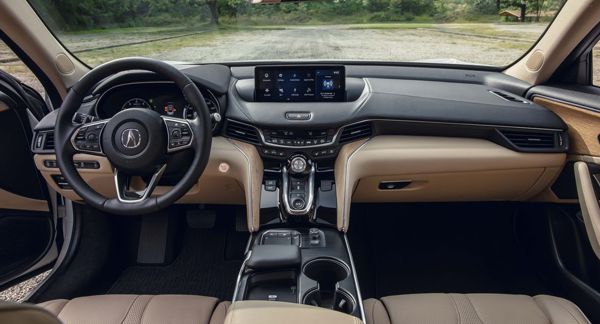 |
|
Solid
build quality compromised by outdated infotainment.
|
|
On the Road
The cabin of TLX mixes high style with quality materials that are on a
par with its German counterparts, while the audio system offers
fantastic sound. However, the same cannot be said to the outdated
infotainment system. Actually, that 10.2-inch display above the center
console is not a touchscreen, so you need to use the touchpad on
transmission tunnel to control the infotainment system, which is
difficult or even frustrating on the move. The analogue instrument is
also quite old-fashioned now. As for cabin space, it is a bit
disappointing. Although the TLX’s exterior is just as large as a
5-Series or A6, its interior is about the same size as a 3-Series or
A4. The front seats are fine, but rear passengers get less head
and leg room than even its smaller rivals. The only advantage is
shoulder room, as the car is much wider. In short, bigger outside,
smaller inside and 200kg heavier, you see why few others would try to
make an FWD car look like an RWD one. Hyundai group would rather go
straight
to build a rear-driver.
As mentioned before, the TLX is considerably slower than its
competitors regardless of engine choices. However, if you have to
choose, the V6 Type S is definitely the one to have. While the
4-cylinder is lighter and not much slower, its sound is gruffy, and the
Michelin Primacy non-performance tires it employs are short of grip,
limiting its roadholding, turn-in response, braking and overall driver
appeal. Its 10-speed automatic is slow to react to manual input, and
refuses to hold a gear when approaching redline. Conclusion: keen
drivers will have little fun in this car.
Frankly, the V6 is not a world-class motor either. While its induction
noise under acceleration is more musical than the four, it is not
exactly sonorous. Moreover, the exhaust noise from the sporty-looking
quad-tailpipes is almost muted, something adequate for an executive car
but not a performance one like this. When accelerate from very low rpm,
the V6 displays a hint of turbo lag that its German rivals managed to
avoid. This is partly due to the mapping of the automatic gearbox,
which usually skips 1st and jumps straight to 2nd to protect the
gearbox. Perhaps 10 ratios are simply too many for such a torquey
motor. Shift speed of Type S is made significantly quicker than the
lesser TLX. Still, manual mode is not true manual. The box still
upshifts automatically a few hundred rpm below its 6200 rpm redline.
In the end, you will give up and let the automatic do the job itself,
something it does quite well.
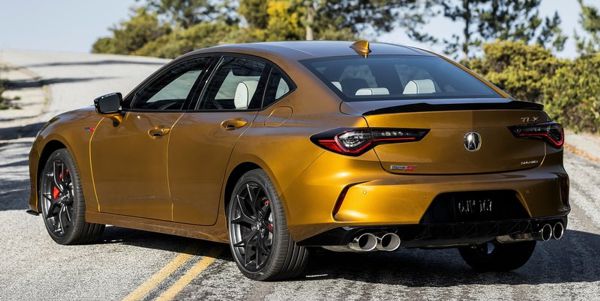
|
|
Fine
chassis dynamics, but let down by powertrain.
|
|
In the twisty, you will find the Type S with its grippy tires, strong
brakes and stiffer suspension pay off in handling. In the sportier
drive modes, body roll is tightly checked while ride quality is
reasonably good. Roadholding is outstanding, thanks in part to the
double-wishbone suspension. The steering is quite light in Honda’s
fashion, but precise and quick, thanks to variable gear ratio rack. You
do feel the extra weight of the car and the burden at its nose, as it
doesn’t turn-in quite as keenly as its lighter rivals. Once the SH-AWD
system hooks up, sending torque to the rear axle and more to the
outside corner, the Type S follows the curve as if on rails. It
balances expertly, displaying neither understeer nor oversteer. You can
lean on the chassis and power out of corner quicker than you thought.
However, you need some commitment to load up the SH-AWD system. Driven
normally, it is basically a front-driver, and you won’t feel it as
nimble as its rivals.
The only shortfall of the TLX is a touchy brake. Honda leaves little
brake pedal travel between zero and full stop, which is fine for
lapping a track, but difficult to drive smoothly in urban conditions.
As for comfort, in Comfort mode the base TLX cruises effortlessly,
smoothly and quietly. Predictably, Type S rides a tad busier and makes
more tire noise, but still easily acceptable for a performance sedan.
Overall speaking, the TLX Type S is underwhelming in powertrain and
performance, but its chassis delivers great handling and fine
refinement, if not quite as rounded as its German rivals. Affordability
remains its strongest card. At $55,000 fully loaded, it undercuts its
rivals considerably. Nevertheless, the Korean duo of Kia Stinger and
Genesis G70 offer rear-wheel drive at even lower costs. As much as the
Acura has improved on its predecessor, its prospect remains difficult.
|
Verdict:    |
|